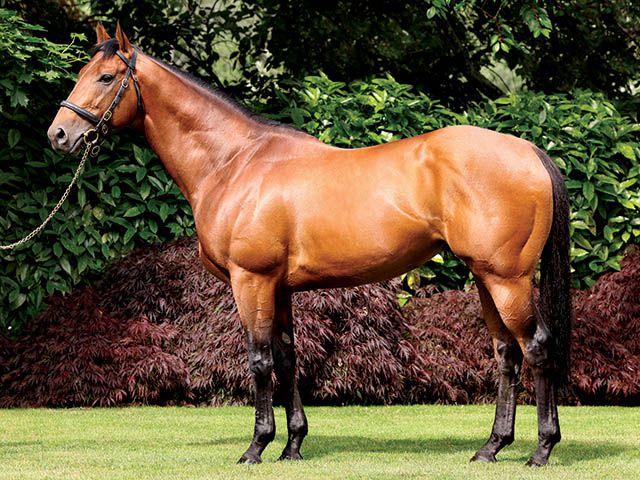When Star Of Seville stormed home from a wide draw in the 2015 Gr1 Prix de Diane Longines at Chantilly, she delivered the first International Grade One victory for her sire, former Cartier champion Duke Of Marmalade, currently resident at Drakenstein Stud Farm in Franschhoek. We reproduce the following article by Andrew Caulfield with kind permission of the Thoroughbred Daily News (TDN).
Every now and then a few innocent words from my columns come back to haunt me. For example, my 2008 analysis of Duke of Marmalade’s pedigree in the TDN included the sentence “Duke of Marmalade will eventually be a very welcome addition to the Coolmore roster, as he comes from a female line with a big reputation for producing stallions.”
Coolmore’s copy-writers leapt on this with the alacrity of a ravenous cougar and for the next few years my quote seemed to feature on just about every advertisement for Duke of Marmalade. It wasn’t long before I began to regret this.
Although his first-crop yearlings were conceived at a fee of €40,000, their median price at the 2011 European yearling sales stood at only 41,000gns. Worse was to follow in 2012, when the young stallion’s 37 runners in Britain and Ireland earned less than £90,000, with only one managing to earn black-type. The knock-on effect was that Duke of Marmalade’s 2012 yearlings, sired at €30,000, achieved a European median of 20,000gns.
Sale
In 2013, Duke of Marmalade was entrusted with only 30 mares, so it came as no great surprise when it was announced in May 2014 that this champion son of Danehill had been sold, to stand at Drakenstein Stud in South Africa. Coolmore’s willingness to sell no doubt owed something to the fact that Duke of Marmalade’s half-brother Ruler of the World had won the 2013 Derby and was destined to join the Coolmore roster in 2015.
Happily for Duke of Marmalade and Drakenstein, the stallion’s record has taken a turn for the better since his first crop turned three in 2013, with the revival peaking when his daughter Star of Seville dominated the Gr1 Prix de Diane Longines two days ago. Another of his 3-year-olds, Sound of Freedom, won the Gr3 Premio Regina Elena, Italy’s equivalent of the 1,000 Guineas.
The X-factor
Altogether he now has eight group winners and a further nine stakes winners from his first three Northern Hemisphere crops. The remarkable aspect of his record is that seven of the eight group winners are fillies, the sole interloper being the gelding Hall of Mirrors (Gr3 Royal Whip S.). The fillies also outnumber the males five to four among the nine stakes winners, which means that 12 of the 17 black-type winners are members of the supposedly weaker sex. The female team also features the likes of Venus de Milo, who went close to winning the 2013 Irish Oaks.
I suppose this dominance of Duke of Marmalade’s daughters could be attributed to the power of his own female line. His third dam is the celebrated Lassie Dear, hence my comment that Duke of Marmalade comes from a female line with a big reputation for producing stallions.
Strong female line
Look through the sires of Gr1 Breeders’ Cup winners and you will find the names of one of Lassie Dear’s sons, Deerhound (sire of Juvenile Fillies winner Countess Diana) and three of her grandsons, namely A.P. Indy (Juvenile Fillies winner Tempera), Summer Squall (Juvenile Fillies winner Storm Song) and Honor Grades (Distaff winner Adoration). Then there’s her great-grandson Kipling (Mile winner Kip Deville). Is it just a coincidence that four of these five Breeders’ Cup winners are fillies? Fillies of course accounted for 16 of A.P. Indy’s 28 Grade One winners and for three of Summer Squall’s four. Lemon Drop Kid, another of Lassie Dear’s grandsons, has five fillies among his six Grade I winners, so it was perhaps predictable that Duke of Marmalade would prove a better sire of fillies than colts.
Stamina or speed?
Star of Seville’s trainer John Gosden understandably believes that a mile and a half is too far for his filly, following her performance in the Investec Oaks (in which she was badly hampered after losing the lead). Duke of Marmalade did stay that distance well enough as a 4-year-old to record a narrow victory in the King George, but his champion status owed more to his four Group 1 successes at around a mile and a quarter.
It is fair to say that Danehill owes his reputation as a brilliant sire of sires largely to his sprinters and milers, such as Dansili, Danehill Dancer, Exceed And Excel, Redoute’s Choice, Fastnet Rock and Rock of Gibraltar. Spare a thought, though, for his middle-distance sons, several of which are having a good time this year. The Arc winner Dylan Thomas – now classed as a National Hunt sire – enjoyed a recent Group 1 double with Pether’s Moon and Dylan Mouth. The sub-fertile Cacique has also added to his reputation via Slumber, whose recent Manhattan Stakes success makes him the third Gr1 winner from an initial crop of 29. Then there’s Tiger Hill, whose current representatives include Oaks d’Italia winner Lovelyn.
If a mile and a half is too far for the free-running Star of Seville, the bottom half of her pedigree is probably to blame. Star of Seville’s Classic success came just a day after her family had enjoyed another victory. This came over five furlongs at Chester via the Acclamation 2-year-old Ejaazah, who became the first winner for English Ballet, a close relative of Star of Seville. English Ballet was sired by another, speedier son of Danehill in Danehill Dancer and she displayed some of her sire’s precocity in winning the Gr3 Sweet Solera Stakes over seven furlongs at two in 2006, when she was also placed in the Gr1 Fillies’ Mile.
Successful nick
The Diane winner’s second dam, Stage Presence, is a daughter of the top-class miler Selkirk and she too did her winning at up to a mile. Selkirk’s broodmare daughters have enjoyed plenty of success with the Danehill male line, notably producing Group 1 winners to Danehill and Rock of Gibraltar, but the most popular choice for them has been Oasis Dream. They have 47 foals of racing age (including seven 2-year-olds) by this champion sprinter and their statistics have been pretty spectacular. They have 29 winners from 34 starters, including eight black-type winners (17%). This explains why Stage Presence has 2011, 2013 and 2015 foals by Oasis Dream, the first being the winning miler Sacred Act and the second a filly named Stage Queen.
Distinguished family
Stage Presence had a distinguished half-sister in Rum Charger. This daughter of Spectrum was a winner at listed and Group 3 levels over seven furlongs before becoming the dam of Winchester, a Theatrical colt who will be remembered in America. After finishing seventh in the 2008 Irish Derby, Winchester was sent to Arlington Park, where he won the Gr1 Secretariat Stakes.
That victory led to his spending the next phase of his career in the States, and he eventually added three more major turf successes, in the Woodford Reserve Manhattan Handicap, Joe Hirsch Turf Classic and Sword Dancer Invitational. Unfortunately the final phase of Winchester’s career – in Australia – proved much less rewarding.
Star of Seville’s fourth dam Hamada was a smart sprinter-miler in France and her fifth dam, the Klairon mare Helvetie, was the second dam of the 1994 Derby winner Erhaab. They are by no means the only Classic winners from this female line, as it traces back to Rosetta, ancestress of such as Altesse Royale, Bustino and Nocturnal Spree.
Article reposted with grateful thanks to Andrew Caulfield and the Thoroughbred Daily News (TDN)











